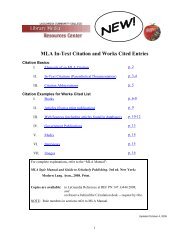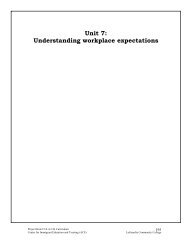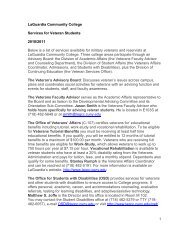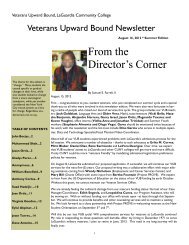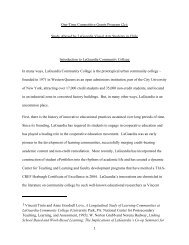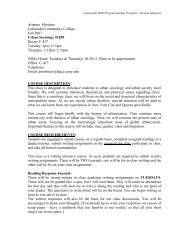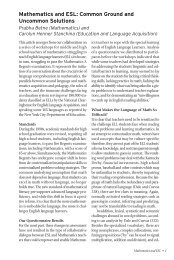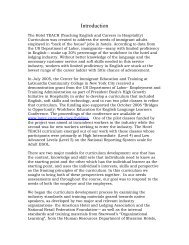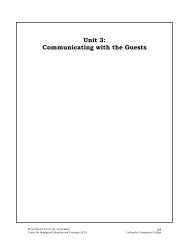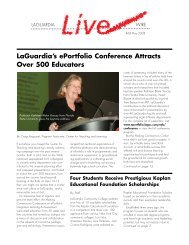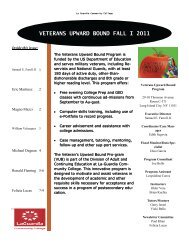Japanese courses brochure - LaGuardia Community College - CUNY
Japanese courses brochure - LaGuardia Community College - CUNY
Japanese courses brochure - LaGuardia Community College - CUNY
You also want an ePaper? Increase the reach of your titles
YUMPU automatically turns print PDFs into web optimized ePapers that Google loves.
Why you should study <strong>Japanese</strong><br />
e <strong>Japanese</strong> language is one of the most popular modern languages in the U.S. and the<br />
number of college students studying <strong>Japanese</strong> is on increase. (10.3% in 2006-2009 according<br />
to Furman et al., (2010)). New York, especially Manhattan and Queens, has a high density<br />
of <strong>Japanese</strong> language learners and a recent survey by MLA shows that more than<br />
50,000 people are currently learning <strong>Japanese</strong> in Queens.<br />
e <strong>Japanese</strong> culture is undoubtedly a major attraction to those learners. <strong>Japanese</strong> food,<br />
such as sushi and ramen, has become a popular choice among New Yorkers. Most college<br />
students in the U.S. have played <strong>Japanese</strong> video games in their youth (or even now) and<br />
have gone to karaoke to hang out with their friends. e pop-culture, including anime and<br />
TV drama, is another major interest among <strong>Japanese</strong> language learners. In addition to<br />
these contemporary culture, Japan has rich traditions and classical literature, such as karate<br />
and judo (<strong>Japanese</strong> martial arts), e Tale of Genji (classical novel written in the 11th century),<br />
and nihonga (classic <strong>Japanese</strong> fine art) to name a few.<br />
e <strong>Japanese</strong> language class at <strong>LaGuardia</strong> CC, with many extracurricular <strong>Japanese</strong> cultural<br />
activities, will provide you with not only the foreign language skill but also a deep appreciation<br />
about the <strong>Japanese</strong> society and culture.<br />
* Furman, N., Goldberg, D., and Lusin, N. (2010). Enrollments in languages other than English in United States<br />
institutions of higher education, fall 2009. Technical report, Modern Language Association, New York, NY.<br />
<strong>Japanese</strong> & Japan-related <strong>courses</strong> at <strong>LaGuardia</strong> <strong>Community</strong> <strong>College</strong><br />
<strong>LaGuardia</strong> <strong>Community</strong> <strong>College</strong> offers the following <strong>Japanese</strong> or Japan-related <strong>courses</strong>.<br />
• Elementary <strong>Japanese</strong> 1 (ELJ101)<br />
• Elementary <strong>Japanese</strong> 2 (ELJ102)<br />
• Intermediate <strong>Japanese</strong> 1 (ELJ103)<br />
• Intermediate <strong>Japanese</strong> 2 (ELJ104)<br />
• <strong>Japanese</strong> for Heritage Students (ELJ105)<br />
• Modern <strong>Japanese</strong> Literature (ELJ201; taught in <strong>Japanese</strong>)<br />
• <strong>Japanese</strong> Literature in Translation (ELJ250; taught in English)<br />
• e Art of Eastern Asia (HUA191)<br />
• East Asian Civilization and Societies (SSH110)<br />
Text and reference books for ELJ101-ELJ104<br />
Hatasa, Y. A., Hatasa, K., and Makino, S. (2009b). Nakama 1A, Introductory <strong>Japanese</strong>: Communication, Culture,<br />
Context. Houghton Mifflin, Boston, Mass., 2nd edition. ISBN: 9780618966288; Course: ELJ101<br />
Hatasa, Y. A., Hatasa, K., and Makino, S. (2009c). Nakama 1A: Student Activities Manual. Houghton Mifflin,<br />
Boston, Mass., 2nd edition. ISBN: 9780618965700; Course: ELJ101<br />
Hatasa, Y. A., Hatasa, K., and Makino, S. (2009d). Nakama 1B, Introductory <strong>Japanese</strong>: Communication, Culture,<br />
Context. Houghton Mifflin, Boston, Mass., 2nd edition. ISBN: 9780547208404; Course: ELJ102<br />
Hatasa, Y. A., Hatasa, K., and Makino, S. (2009e). Nakama 1B: Student Activities Manual. Houghton Mifflin,<br />
Boston, Mass., 2nd edition. ISBN: 9780547208633; Course: ELJ102<br />
Hatasa, Y. A., Hatasa, K., and Makino, S. (2010a). Nakama 2. Heinle and Heinle, Boston, Mass., 2nd edition<br />
edition. ISBN: 9780547171647; Course: ELJ103, ELJ104<br />
Hatasa, Y. A., Hatasa, K., and Makino, S. (2010c). Nakama 2 Student Activities Manual (SAM). Heinle and<br />
Heinle, Boston, Mass. ISBN: 9780547171708; Course: ELJ103, ELJ104.<br />
Text and reference books for ELJ105<br />
Miura, A. and Hanaoka-McGloin, N. (2008a). An Integrated Approach to Intermediate <strong>Japanese</strong> Workbook.<br />
The Japan Times, 2nd edition edition. ISBN: 9784789013086; Course: ELJ105; Price: 1,575 yen.<br />
Miura, A. and Hanaoka-McGloin, N. (2008b). An Integrated Approach to Intermediate <strong>Japanese</strong>. The Japan<br />
Times, 2nd edition edition. ISBN: 9784789013079; Course: ELJ105; Price: 3,360 yen.<br />
Oka, M. (2010). Tobira: Power Up Your KANJI: 800 Basic KANJI as a Gateway to Advanced <strong>Japanese</strong>. Kuroshio<br />
Publishers, Tokyo, Japan. ISBN: 9784874244876; Course: ELJ105<br />
Text and reference books for ELJ201 & ELJ250<br />
Goossen, T. W. (1994). The Oxford book of <strong>Japanese</strong> Short Stories. Oxford University Press, Oxford, UK, 2nd<br />
edition. ISBN: 9780802150585; Course: ELJ250; Price $16.95<br />
Keene, D. (1994). Anthology of <strong>Japanese</strong> Literature: From the Earliest Era to the Mid-Nineteenth Century.<br />
Grove Press, New York, NY, 2nd press edition. ISBN: 9780802150585; Course: ELJ250; Price $16.95.<br />
Keene, D. (1994b). Modern <strong>Japanese</strong> Literature: From 1868 to the Present Day. Grove Press, New York, NY, 2nd<br />
edition. ISBN: 9780802150950; Course: ELJ250; Price: $15.95.<br />
More about the <strong>Japanese</strong> language <strong>courses</strong><br />
<strong>LaGuardia</strong> <strong>Community</strong> <strong>College</strong> offers a two-year long <strong>Japanese</strong> language <strong>courses</strong>. See<br />
http://bit.ly/course_schedule for the schedule of <strong>Japanese</strong> <strong>courses</strong>. e proficiency goal in<br />
each of the <strong>Japanese</strong> language <strong>courses</strong> is as following:<br />
1 6<br />
Printed on: Saturday, November 16, 2013 (Tomonori Nagano)



